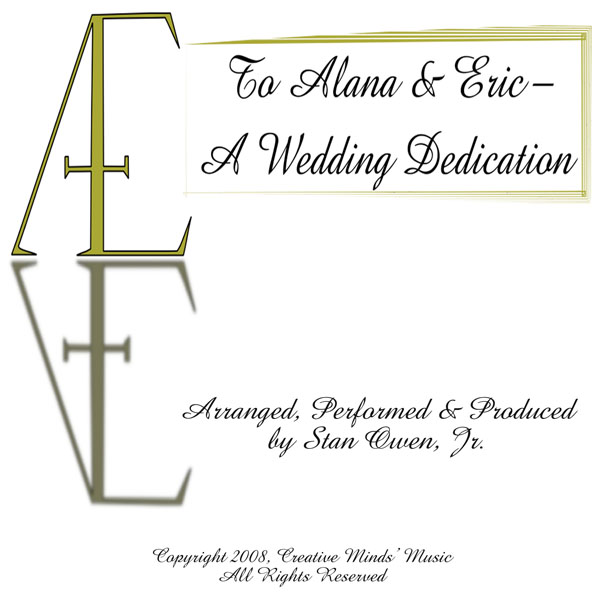From the day that I heard of the August 8th, 2008 wedding plans of my good friends: Alana and Eric, and their appointment with a harpist to select wedding music, I knew that my wedding gift to them would be a recorded series of (my) arrangements of (their) wedding music. The notes that follow are based on the notes I wrote for the “A Wedding Dedication” CD insert.
I hope that you enjoy these dedicated performances.

1) Call to be seated: Jesu, Joy of Man’s Desiring by J.S. Bach
“Jesu, Joy of Man’s Desiring” is the tenth piece, a Chorale, from J.S. Bach’s Cantata 147. Musical lore recounts that this piece was written during a period of Bach’s career in which he was writing one cantata per week to satisfy his responsibilities as choirmaster. This recording was conceived and performed using public-domain notation of the original score. This arrangement includes pipe-organ and harpsichord accompaniment. Bach would likely have only used organ. In this arrangement, violins, violas, cellos, and (string) basses have been substituted for the original Chorale’s voices: sopranos, altos, tenors, and basses (respectively).
2) Entry of the minister and the groom: Hymne by Vangelis
I transcribed the notation of the Vangelis “Hymne” from online recordings. This arranger attempted to keep the arrangement similar in length, tempo, and instrumentation to Vangelis’ original recording.
3) Entry of the bride with her father: Canon in D Major by Pachelbel
Written around 1680, the “D Major Canon” is Pachelbel’s best known piece; and, is one of the world’s best known “rounds” (like “Row, Row, Row Your Boat”). The original manuscript is scored for three violin sections with a bass part that repeats over, and over (basso continuo). This performance was created from a public-domain version of the original score. Violins I are staged far-right, Violins II are far left, and Violins III are center. Cellos play the bass part and sit near center-stage. A stage-left harpsichord outlines the harmonies implied by the combined string parts.
4) Recessional: Ode To Joy by Ludwig Von Beethoven
Beethoven’s Ninth Symphony (1824) includes a setting of Fredrich Schiller’s poem “An die Freude” (“Ode to Joy” published, 1786). The tune has been so well-loved through the years, that in modern day it is used both as the Anthem of the European Union and as the well-known church hymn: “Joyful, Joyful, We Adore Thee.” It is the hymn version of this song that I have arranged. The arrangement consists of two verses of the hymn with solos, duets, and trios by various combinations of clarinet, oboe, and flute, and violins. At the middle of each verse, a trumpet fanfare reinforces the regal nature of the tune. String-basses enter in the last phrases of the second verse to provide a solid bottom to the final cadence.
5) Postlude: Watermark by Enya
This is the title-song from Enya’s 1989 album with the same name. I transcribed this song from an audio version provided by a mutual friend. In the arrangement, I attempted to remain faithful to the spirit of the Enya’s original performance (key, tempos, and instrumentation including Enya’s slightly detuned/chorused acoustic piano).

Leave a Reply